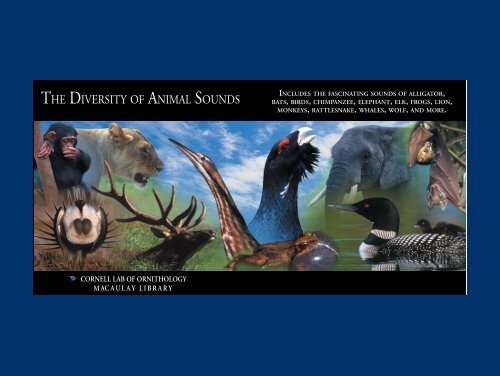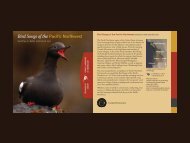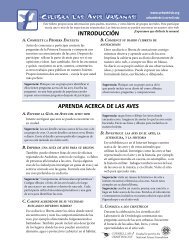THE DIVERSITY OF ANIMAL SOUNDS
THE DIVERSITY OF ANIMAL SOUNDS
THE DIVERSITY OF ANIMAL SOUNDS
You also want an ePaper? Increase the reach of your titles
YUMPU automatically turns print PDFs into web optimized ePapers that Google loves.
The DiversiTy of AnimAl sounDs<br />
cOrNEll lab <strong>OF</strong> OrNiTHOlOGy<br />
M ac a u l a y l i b r a r y<br />
Includes the fascInatIng sounds of allIgator,<br />
bats, bIrds, chImpanzee, elephant, elk, frogs, lIon,<br />
monkeys, rattlesnake, whales, wolf, and more.
the dIversIty of anImal sounds<br />
Introduction<br />
From the roar of a Red Howler Monkey to the complex mimicry of a Superb<br />
Lyrebird, animal sounds are remarkably diverse. And because animal sounds are<br />
so varied, the potential for hearing new and wonderful sounds is inexhaustible.<br />
This CD celebrates the diversity of animal sound. The accompanying<br />
pamphlet provides some general explanations for the underlying reasons for<br />
animal sound diversity.<br />
Animals use sounds to maintain the social fabric of their lives. They use<br />
sound to attract and court mates, determine which nestling gets the worm,<br />
repel rivals, defend territories, coordinate group activities, announce food<br />
finds, warn others of predators, and tell predators that they have been detected.<br />
Each social function requires the exchange of different kinds of information,<br />
producing a multitude of sounds with diverse physical properties.<br />
An animal’s anatomy affects the kinds of sounds produced. Terrestrial<br />
vertebrates such as frogs, birds, and mammals use their respiratory system to<br />
create sounds. Terrestrial arthropods including insects do not pump sufficient<br />
volumes of air into and out of their bodies to vocalize, but instead rub parts<br />
of their hard exoskeletons together to generate rasps, buzzes, and clicks. Body<br />
size plays a role here as well. For example, only large animals can generate low<br />
frequencies. Thus sounds used for the same social function will likely differ<br />
among large and small species.<br />
Habitat plays an important role in shaping sound diversity. Sounds may<br />
become distorted as they travel through the habitat. Animals minimize this<br />
distortion by producing sounds that are least affected by their habitat. For<br />
example, forest trees generate echoes that will disrupt the temporal patterning<br />
in a sound. Open country habitats produce few echoes. As a result, forest<br />
birds generally use songs with long, pure tones, while most prairie birds<br />
produce rapid songs with many short notes.<br />
The distance from one animal to another also influences its use of sound.<br />
Group-living animals need a larger diversity of sounds than do solitary<br />
animals. The habitat may impose greater constraints on sound production<br />
when animals live far apart, since they must choose sounds that travel well<br />
over long distances. In contrast, sound distortion is rarely a problem for<br />
highly social animals that communicate at short range.<br />
Finally, sounds are shaped by listeners. Animals, like humans, can lie, but<br />
they gain little if listeners selectively respond to signals that can only convey<br />
honest information. For example, females often prefer larger or older mates.<br />
Female frogs select males with lower-pitched calls because only larger frogs<br />
can produce calls with a low pitch. Female birds may favor males with larger<br />
song repertoires because only older males will have had the time to master<br />
large numbers of songs. In both cases, the female’s preference for a particular<br />
type of signal keeps males honest.
The sheer diversity of animal sounds is impressive in its own right, but<br />
for many of us, understanding the underlying reasons for this variation gives<br />
us an even deeper appreciation. As you listen to this CD, consider how<br />
social function, anatomy, habitat, dispersion, and the need for honesty may<br />
have influenced the sounds you hear. To help you navigate, we have grouped<br />
the sounds according to their social function.<br />
First we highlight sounds used in courtship and mating. These sounds<br />
are likely to differ depending upon whether a) males mate with many<br />
females but do not reside with them or provide paternal care (promiscuous<br />
species, tracks - 0), b) males mate with more than one female and live with<br />
them in the same group or colony (polygynous species, tracks - 7), or c)<br />
each male mates with a single female and remains with her at least through<br />
a breeding season (monogamous species, tracks 8-47).<br />
Next we present sounds used for the coordination of nonsexual activities<br />
(tracks 48-57). This category includes group territorial calls, calls that<br />
synchronize group movements, and food and predator announcements.<br />
Some animals direct sounds at other species. Usually, this involves an<br />
animal communicating with one of its predators (tracks 58-60).<br />
We conclude with sounds from two recently extinct species whose<br />
sound communication systems were seriously undermined as their<br />
habitats were altered and their densities plummeted (tracks 6 -6 ). This<br />
again points up the critical role that sound can play in animals’ lives.<br />
Using this compact disc<br />
Each species presented on this compact disc is individually tracked to permit<br />
rapid access. The track number appears to the left of each common name.<br />
In cases where a recording was slowed down or sped up (to make it easier<br />
for a human to hear), the sound is presented at normal speed, with speed<br />
adjustments in successive tracks.
SpEciES playliST<br />
Display signals of<br />
promiscuous males<br />
Males of promiscuous species mate with<br />
many different females but do not live<br />
with them. Their sole contribution to the<br />
reproductive process is the provision of<br />
sperm. This creates intense competition,<br />
and promiscuous species often produce<br />
the most striking male courtship sounds.<br />
Courtship sounds of promiscuous males<br />
vary depending upon how the males<br />
are distributed in their habitat. Males<br />
that display solitarily or in a dispersed<br />
fashion tend to use more complex and<br />
variable vocalizations. Their challenge is<br />
to entice an interested female to remain<br />
long enough to approach and mate.<br />
One effective strategy is to advertise<br />
their age or experience by using long<br />
and complex vocalizations. In contrast,<br />
males that display in groups, called<br />
“choruses” for frogs and “leks” for most<br />
other animals, are more easily compared<br />
by visiting females. Females thus favor<br />
simple but challenging sounds that are<br />
repeated rapidly to reveal differences in<br />
male vigor, health, or experience.<br />
Anatomy and habitat often combine<br />
to create diversity in sounds of<br />
promiscuous animals. Insects such<br />
as treehoppers cannot produce vocal<br />
signals by breathing, but instead<br />
make tonal sounds by vibrating their<br />
abdomens rapidly. These sounds<br />
are then transmitted through the<br />
vegetation on which the treehopper<br />
sits. Where females favor larger mates,<br />
males tend to produce sounds with as<br />
low a frequency as possible to advertise<br />
their size (e.g., frogs and alligators).<br />
Low frequencies also transmit better<br />
than higher frequencies when close to<br />
the ground. As a result, large birds with<br />
terrestrial leks, such as Greater Sage<br />
Grouse, include low frequencies in<br />
their displays.<br />
The following tracks present sounds<br />
made by promiscuous males starting<br />
with those that display solitarily,<br />
followed by those displaying on<br />
dispersed leks (where a female can<br />
compare several but not all males from<br />
a given location), and ending with<br />
highly aggregated lek species (where<br />
females can easily compare all males in<br />
the lek).<br />
Track Number/Common Name/<br />
Scientific Name<br />
1. Satin bowerbird<br />
Ptilonorhynchus violaceus<br />
Males are solitary or highly dispersed<br />
Displaying male at bower<br />
Australia, New South Wales,<br />
Washpool National Park<br />
Mary Katz<br />
LNS 468 6<br />
2. American Alligator<br />
Alligator mississippiensis<br />
Males are solitary<br />
Courtship vocalization from male<br />
(stereo recording)<br />
United States, Georgia, Okefenokee<br />
Swamp, Suwannee Canal Run<br />
Thomas Wiewandt<br />
3. Jaguar<br />
Panthera onca<br />
Males are solitary<br />
Male producing loud “sawing” call<br />
Germany, Cologne, Cologne Zoo<br />
Gustav Peters<br />
4. Superb lyrebird<br />
Menura novaehollandiae<br />
Males are solitary<br />
Song with mimicry<br />
Australia<br />
F. N. Robinson<br />
LNS 8004<br />
5. Three-humped Treehopper<br />
Heteronotus trinodosus<br />
Solitary displaying males of this<br />
insect species move about and<br />
may interact with other males<br />
Plant-borne sounds (vibrations)<br />
from two nearby males<br />
Panama, Rio Guanche<br />
Rex Cocroft<br />
6. yellow buffalo Treehopper<br />
Stictocephala lutea<br />
Solitary displaying males move<br />
about and may interact with<br />
other males<br />
Plant-borne sounds (vibrations)<br />
from nearby males<br />
United States, New York,<br />
Tompkins Co., Freeville<br />
Rex Cocroft<br />
4
7. capercaillie<br />
Tetrao urogallus<br />
Males of this large grouse species<br />
display solitarily or on dispersed<br />
leks (within hearing range of each<br />
other)<br />
Single male displaying<br />
(stereo recording)<br />
Scotland, Inverness<br />
Gregory F. Budney<br />
8. Franquet’s Epauletted bat<br />
Epomops franqueti<br />
Males on dispersed leks<br />
Individual male advertisement calls<br />
Gabon, Makokou, south bank<br />
of Ivindo River<br />
Jack W. Bradbury<br />
9. bowhead Whale<br />
Balaena mysticetus<br />
Males on dispersed leks or solitary<br />
Song given on northward migration<br />
to feeding grounds<br />
United States, Alaska, North Slope<br />
coast near Barrow<br />
Christopher W. Clark<br />
10. Humpback Whale<br />
Megaptera novaeangliae<br />
Males on dispersed leks<br />
Breeding season song<br />
Hawaiian Islands, Hawaii,<br />
south Kohala coast<br />
Adam Frankel<br />
11. Knudsen’s Frog<br />
Leptodactylus knudseni<br />
Male chorus<br />
Male call<br />
Peru, Madre de Dios,<br />
Tambopata Reserve<br />
Rex Cocroft<br />
12. Tungara Frog<br />
Physalaemus pustulosus<br />
Male chorus<br />
Calls (stereo recording)<br />
Panama, Gamboa<br />
Rex Cocroft and Stanley Rand<br />
13. Smoky Jungle Frog<br />
Leptodactylus pentadactylus<br />
Male choruses<br />
Chorus with Tungara Frog and<br />
Panamanian Narrow-mouth<br />
Frog (high trill) in background<br />
(stereo recording)<br />
Panama, Gamboa, Kent’s Marsh<br />
Rex Cocroft<br />
14. club-winged Manakin<br />
Machaeropterus deliciosus<br />
Dispersed or small lek<br />
Vocal and mechanical sounds at lek<br />
Ecuador, Pinchincha, Reserva<br />
Maquipucuna<br />
Kim Bostwick<br />
15. black-and-gold cotinga<br />
Tijuca atra<br />
Dispersed or small lek<br />
Song delivered by several<br />
individuals at lek<br />
Brazil, Rio de Janeiro, Itatiaia<br />
National Park<br />
Theodore A. Parker, III<br />
LNS 778<br />
16. red-ruffed Fruitcrow<br />
Pyroderus scutatus<br />
Dispersed or small lek<br />
Display by four to six birds<br />
Venezuela, Bolivar, Santa Maria<br />
Paul A. Schwartz<br />
LNS 6 8<br />
17. capuchinbird<br />
Perissocephalus tricolor<br />
Dispersed or small lek<br />
Lek with five to ten calling males<br />
(stereo recording)<br />
Guyana, Potaro-Suparuni, Surama<br />
Bret M. Whitney<br />
LNS 96600<br />
18. Screaming piha<br />
Lipaugus vociferans<br />
Small lek<br />
Five to six birds displaying at lek<br />
(stereo recording)<br />
Guyana, Region 9-North<br />
Rupununi, Iwokrama<br />
Gregory F. Budney<br />
5
19. bearded Manakin<br />
Manacus manacus<br />
Large lek<br />
Mechanical sounds at hybrid zone<br />
lek where both M. manacus and<br />
M. aurantiacus occur<br />
Colombia, Cauca, Guapi<br />
Mark B. Robbins<br />
LNS 7 8<br />
20. Greater Sage Grouse<br />
Centrocercus urophasianus<br />
Large lek<br />
Calls and mechanical sounds at<br />
active lek (stereo recording)<br />
Oregon, Harney Co., near Malheur<br />
National Wildlife Refuge<br />
David S. Herr<br />
Territorial and courtship signals in<br />
polygynous species<br />
Polygynous males mate with multiple<br />
females but, unlike promiscuous species,<br />
live in social groups with those females<br />
or at least with the young. Males can use<br />
three strategies to acquire mates. The<br />
first is to offer paternal care to multiple<br />
females in exchange for matings. This<br />
is the approach of some species of<br />
fish in which males provide all of the<br />
parental care. A second strategy is to<br />
exclude rival males from an existing<br />
herd or troop of females. This creates<br />
the “harems” seen in many mammals.<br />
A third strategy is to defend a resource<br />
required by females such as a nesting<br />
site, food patch, or refuge. The male<br />
allows only females to have access to the<br />
resource and thus obtains any matings<br />
when those females are receptive.<br />
The advertisement calls of<br />
polygynous males differ depending on<br />
which method they use to attract and<br />
retain females. Female fish that choose<br />
their mates may favor male signals<br />
that honestly reflect health and vigor.<br />
These are likely to be simple sounds<br />
that males must repeat at a high rate<br />
for long periods (midshipman fish, for<br />
example). When males win mates by<br />
defending a group of females or their<br />
resources, one might expect males to<br />
direct their calls more at rival males<br />
than at reluctant females. This is often<br />
the case. Recent research, however,<br />
shows that polygynous males will direct<br />
sounds at both sexes when it is likely<br />
that females will sneak out of their<br />
usual group to mate with a particularly<br />
attractive male in another group. Where<br />
the composition of female groups is<br />
unstable (e.g., Greater Sac-winged Bats),<br />
male sounds may play an even larger role<br />
in female attraction than in rival male<br />
repulsion. Advertisement calls are then<br />
more like those of solitary promiscuous<br />
species in having long and complex<br />
motifs.<br />
In mammals, larger males often win<br />
contests over female groups or resources.<br />
It thus makes sense for larger males<br />
to defend females by emitting low<br />
frequency calls that cannot be faked<br />
by smaller males (as in elk). Males that<br />
have to defend large territories to enclose<br />
female groups or defend resources also<br />
require loud and low frequency signals<br />
that can travel long distances (howler<br />
monkeys). Territorial control in birds is<br />
more often based on age and experience,<br />
and the requisite male calls tend to be<br />
difficult to perform without extensive<br />
practice (as in oropendolas).<br />
21. plainfin Midshipman<br />
Porichthys notatus<br />
The male of this fish species<br />
offers paternal care in exchange<br />
for matings<br />
Grunt calls and hum from<br />
chorusing males<br />
(stereo recording)<br />
United States, California,<br />
Tomales Bay<br />
Andrew H. Bass<br />
22. Elk (Wapiti)<br />
Cervus elaphus canadensis<br />
Male defense of female herd<br />
Bugling from male elk<br />
(stereo recording)<br />
Note low frequency notes on<br />
end of each bugle<br />
United States, Wyoming,<br />
Yellowstone National Park<br />
David S. Herr<br />
23. russet-backed Oropendola<br />
Psarocolius angustifrons<br />
A male bird’s defense of nesting tree<br />
Song<br />
Bolivia, La Paz, Pahuil<br />
Theodore A. Parker, III<br />
LNS 444 6<br />
6
24. Olive Oropendola<br />
Psarocolius bifasciatus<br />
A male bird’s defense of<br />
nesting tree<br />
Song<br />
Peru, Madre de Dios,<br />
Tambopata Reserve<br />
Theodore A. Parker, III<br />
LNS 985<br />
25. Greater Sac-winged bat<br />
Saccopteryx bilineata<br />
Harem male defense of females and<br />
roosting site<br />
Song and hover display to females<br />
(normal speed)<br />
Trinidad, Nariva Swamp,<br />
Bush Bush<br />
Jack W. Bradbury<br />
26. Greater Sac-winged bat<br />
Saccopteryx bilineata<br />
Harem male defense of females and<br />
roosting site<br />
Song and hover display to females<br />
(same as track 5 at<br />
one-quarter speed)<br />
Trinidad, Nariva Swamp,<br />
Bush Bush<br />
Jack W. Bradbury<br />
27. red Howler Monkey<br />
Alouatta seniculus<br />
Male defends female group<br />
and territory<br />
Calls from male<br />
Peru, Madre de Dios, Manu<br />
National Park, Cocha Cashu<br />
Theodore A. Parker, III<br />
LNS 4440<br />
Territorial and courtship displays<br />
of monogamous pairs<br />
The majority of birds and a minority<br />
of mammals live in monogamous pairs.<br />
Males use songs to attract a female and<br />
establish a territory. After pairing, these<br />
animals may use fewer or different<br />
vocal signals to guard their mate,<br />
defend the pair’s territory, or coordinate<br />
breeding synchrony. However, the fact<br />
that some monogamous male birds<br />
continue elaborate singing long after<br />
pairing appears to be due in part to<br />
the possibility of obtaining clandestine<br />
matings with neighboring females.<br />
Monogamous species differ<br />
markedly in their division of labor.<br />
The appropriate division for any species<br />
depends on the habitat in which the<br />
animals live, their diet, their nesting<br />
site, and their expected longevity. Once<br />
defined, the division of labor is then<br />
reflected by the degree to which the<br />
male or both members undertake vocal<br />
defense tasks. Our series of sounds<br />
from monogamous pairs begins at one<br />
extreme, in which males perform all<br />
of the vocal advertising, and moves to<br />
steadily increasing contributions by<br />
females. The final species all use highly<br />
coordinated pair duets for territorial and<br />
mate defense.<br />
28. Great potoo<br />
Nyctibius grandis<br />
Male does territorial defense<br />
Call<br />
Peru, Loreto, north bank of the<br />
Rio Napo, Quebrada Sucusari<br />
Sucusari Camp<br />
Theodore A. Parker, III<br />
LNS 7 6<br />
29. common potoo<br />
Nyctibius griseus<br />
Male does territorial defense<br />
Call<br />
Venezuela, Guárico, Guaitoco<br />
Paul A. Schwartz<br />
LNS 59964<br />
30. common Nighthawk<br />
Chordeiles minor<br />
Male does territorial defense<br />
“Peent” vocalization and<br />
“booming” (created by air<br />
rushing through primary flight<br />
feathers during flight display<br />
dive) (stereo recording)<br />
United States, Oregon, Harney<br />
Co., .5 km S of Frenchglen<br />
David S. Herr<br />
31. american bittern<br />
Botaurus lentiginosus<br />
Male does territorial defense<br />
Call<br />
United States, New York,<br />
Franklin Co., Bay Pond Park<br />
Steven R. Pantle and<br />
Gregory F. Budney<br />
LNS 5 66<br />
7
32. common Nightingale<br />
Luscinia megarhynchos<br />
Male does territorial defense<br />
Song delivered at : 5 A.M.<br />
Netherlands, Noord-Holland,<br />
Bloemendaal, National Park<br />
Kennemerduinen<br />
Arnoud B. van den Berg<br />
LNS 7 6 0<br />
33. brown-backed Solitaire<br />
Myadestes occidentalis<br />
Male does territorial defense<br />
Song<br />
El Salvador, Santa Ana,<br />
Cerro Verde<br />
Walter A. Thurber<br />
LNS 6<br />
34. Winter Wren<br />
Troglodytes troglodytes<br />
Male does territorial defense<br />
Song (normal speed)<br />
(stereo recording)<br />
United States, New York,<br />
Franklin Co., Bay Pond Park<br />
Gregory F. Budney<br />
35. Winter Wren<br />
Troglodytes troglodytes<br />
Male does territorial defense<br />
Song (same as track 4 at<br />
one-half speed), (stereo recording)<br />
United States, New York,<br />
Franklin Co., Bay Pond Park<br />
Gregory F. Budney<br />
36. canyon Wren<br />
Catherpes mexicanus<br />
Male does territorial defense<br />
Song<br />
United States, Arizona, Pima Co.,<br />
8 km NW of Nogales<br />
Geoffrey A. Keller<br />
LNS 40607<br />
37. Musician Wren<br />
Cyphorhinus arada<br />
Both members of pair sing<br />
Song from a single individual<br />
Peru, Madre de Dios, Manu<br />
National Park, Cocha Cashu<br />
Theodore A. Parker, III<br />
LNS 97 4<br />
38. Tui<br />
Prosthemadera novaeseelandiae<br />
Both members of pair sing<br />
Song (normal speed)<br />
New Zealand, Kapiti Island<br />
Leslie B. McPherson<br />
39. Tui<br />
Prosthemadera novaeseelandiae<br />
Both members of pair sing<br />
Song (same as track 8 at<br />
one-half speed)<br />
New Zealand, Kapiti Island<br />
Leslie B. McPherson<br />
40. Galapagos petrel<br />
Pterodroma phaeopygia<br />
Both sexes call during pair<br />
formation<br />
Calls at night from several birds<br />
in flight over nest burrows<br />
(stereo recording)<br />
Galapagos Islands, Isla Santiago<br />
Gregory F. Budney and<br />
James L. Gulledge<br />
41. common loon<br />
Gavia immer<br />
Pairs duet to defend territory<br />
Wail call by two individuals<br />
(stereo recording)<br />
United States, New York,<br />
Hamilton Co., Mason Lake<br />
Steven R. Pantle and<br />
Kimberly C. Pantle<br />
42. yellow-naped amazon<br />
Amazona auropalliata<br />
Pairs of this parrot species duet to<br />
defend nests<br />
Pair duet<br />
Costa Rica, Guanacaste,<br />
Santa Rosa National Park<br />
Jack W. Bradbury and Jennifer Webb<br />
43. australian Magpie<br />
Gymnorhina tibicen<br />
Pairs and young chorus to<br />
defend territories<br />
Pair duet<br />
Australia, Victoria, near Carlsbrook<br />
Margaret J. Widdowson<br />
8
44. White-handed Gibbon<br />
Hylobates lar<br />
Pairs and young duet to defend<br />
territory<br />
Family Chorus<br />
Thailand, Northeast, Khao Yai<br />
National Park<br />
Arnoud B. van den Berg and<br />
Cecilia A.W. Bosman<br />
LNS 4 8<br />
45. Horned Screamer<br />
Anhima cornuta<br />
Pairs duet to defend nests and<br />
each other<br />
Pair duet<br />
Peru, Madre de Dios,<br />
Tambopata Reserve<br />
Theodore A. Parker, III<br />
LNS 4<br />
46. Gray-necked Wood-rail<br />
Aramides cajanea<br />
Pairs duet to defend territories<br />
Pair duet<br />
Costa Rica, Puntarenas,<br />
Corcovado National Park<br />
Steven R. Pantle<br />
47. Marbled Wood-Quail<br />
Odontophorus gujanensis<br />
Pairs duet to defend family group<br />
and nest<br />
Pair duet (note that synchrony<br />
breaks down as birds move out<br />
of visual contact) (stereo<br />
recording)<br />
Ecuador, Napo, south bank<br />
of the Rio Aguarico,<br />
Zancudo Cocha<br />
Gregory F. Budney and<br />
David L. Ross, Jr.<br />
Group defense and<br />
coordination signals<br />
Animals that live in stable groups<br />
usually use different sounds to<br />
convene dispersed members, defend<br />
a group territory, ensure avoidance<br />
of competing groups, and coordinate<br />
group movements. Because the<br />
distances between different groups can<br />
be large, inter-group signals are often<br />
loud and designed to travel effectively<br />
within the species’ typical habitat.<br />
They are also complex enough to<br />
provide information about the species,<br />
group, and individual identities of<br />
the callers. Lions and wolves often<br />
give their group calls at night when<br />
atmospheric conditions for sound<br />
propagation are optimal. Elephants<br />
are capable of making exceedingly low<br />
frequency sounds that travel close to<br />
the ground over enormous distances.<br />
This enables distant members of the<br />
group to coordinate their movements so<br />
as to meet at convenient locations. The<br />
critical factors creating diversity in group<br />
calls include the distance over which the<br />
signals must travel, the species’ typical<br />
habitat, the need for individual or group<br />
identification, and the degree to which<br />
participants seek to coordinate their<br />
movements.<br />
48. indri<br />
Indri indri<br />
Territorial defense with group calls<br />
Typically three to five individuals<br />
consisting of an adult pair and<br />
their offspring (stereo recoring)<br />
Madagascar, Périenet<br />
Mark Barsamian and Amy Dunham<br />
LNS 9790<br />
49. Gray Wolf<br />
Canis lupus<br />
Territorial defense with group calls<br />
Group howls by pack<br />
Canada, Ontario, Algonquin<br />
Provincial Park<br />
William W. H. Gunn<br />
LNS 56760<br />
50. Great blue Turaco<br />
Corythaeola cristata<br />
Territorial defense with group calls<br />
Flock calls<br />
Kenya, Nyanza, Kakamega Forest<br />
Dale A. Zimmerman<br />
LNS 046<br />
51. lion<br />
Panthera leo<br />
Territorial defense with group calls<br />
Group roaring<br />
Namibia, Etosha National Park<br />
Holly Payne and Flip Stander<br />
LNS 5 4 8<br />
9
52. Dusky Titi Monkey<br />
Callicebus moloch<br />
Territorial defense with group calls<br />
Calls by family troop<br />
Peru, Madre de Dios, Manu<br />
National Park, Cocha Cashu<br />
Theodore A. Parker, III<br />
LNS 0000<br />
53. laughing Kookaburra<br />
Dacelo novaeguineae<br />
Territorial defense with group calls<br />
Group chorus (stereo recording)<br />
Australia, Queensland<br />
Ellie Brown<br />
54. african Elephant<br />
Loxodonta africana<br />
Low frequency calls to coordinate<br />
intergroup movements<br />
Greeting rumbles as two<br />
individuals meet<br />
Central African Republic, Dzanga<br />
Katharine Payne<br />
55. common raven<br />
Corvus corax<br />
Movement coordination signal<br />
“Gronk” call, “oooou” call,<br />
popping<br />
United States, Oregon, Wasco Co.,<br />
Mt. Hood National Forest<br />
Geoffery A. Keller<br />
LNS 50 9<br />
56. common loon<br />
Gavia immer<br />
Alarm calls<br />
Tremolo call (stereo recording)<br />
United States, New York,<br />
Hamilton Co., Mason Lake<br />
Steven R. Pantle and<br />
Kimberly C. Pantle<br />
57. chimpanzee<br />
Pan troglodytes<br />
Advertisement of food finds to<br />
group members<br />
Pant-hoots<br />
Tanzania, Mahale National Park<br />
John Mitani<br />
LNS 54077<br />
Interspecific signals<br />
Some animals use sounds to<br />
communicate with their predators.<br />
Many predators, such as large cats, must<br />
approach their prey by stealth to get close<br />
enough for an attack. Prey such as deer,<br />
antelope, and beavers use special sounds<br />
to notify predators that they have been<br />
spotted at a distance. Other animals are<br />
toxic or otherwise dangerous and use<br />
bright colors or sounds to warn potential<br />
predators of the danger in attacking them<br />
(aposematic signals). The startling sound<br />
of a rattlesnake is a classic example.<br />
58. Mule Deer<br />
Odocoileus hemionus<br />
Predator notification signals<br />
Snorts, stomping, and “stotting”<br />
(stiff-legged bounding on all<br />
four hooves) (stereo recording)<br />
United States, California, Sierra<br />
Co., Butterfly Valley<br />
Gregory F. Budney<br />
59. american beaver<br />
Castor canadensis<br />
Predator notification signal<br />
Tail slap on water<br />
(stereo recording)<br />
United States, New York,<br />
Schuyler Co., Cayuta<br />
Gregory F. Budney<br />
60. Western Diamondback<br />
rattlesnake<br />
Crotalus atrox<br />
Aposematic (warning) signal<br />
Rattle<br />
United States, New York,<br />
Tompkins Co., Ithaca (captive)<br />
Harry W. Greene and<br />
Steven R. Pantle<br />
0
Extinct species<br />
As humans alter natural habitats,<br />
the sounds evolved by animals for<br />
communication may no longer be<br />
effective in these new contexts. Birds<br />
such as woodpeckers require access to<br />
properly aged trees of the right species<br />
to create the loud drumming used<br />
to keep other pairs from infringing<br />
on their territory. Without suitable<br />
nesting trees and drumming posts,<br />
territorial behavior breaks down and<br />
breeding success plummets. This was<br />
surely the experience of the Ivorybilled<br />
Woodpecker which is now either<br />
extinct or remnant only as a few isolated<br />
individuals. Even if habitats remain<br />
intact, introduced predators and diseases<br />
often reduce native animal densities to<br />
the point where their natural signals can<br />
no longer bridge the distances between<br />
them. There is nothing more heartbreaking<br />
than to hear a lone bird such<br />
as one of the last Kauai Oo, included<br />
on this CD, plaintively advertising<br />
itself but receiving no answer. Without<br />
the frequent interactions that sounds<br />
provide, the social fabric of a species<br />
breaks down and the necessary functions<br />
of reproduction and cooperative<br />
survival fail. Our last two cuts remind<br />
the listener of how important it is to<br />
preserve the sound world of our native<br />
animals and how easily they and that<br />
world can be lost, leaving us with only<br />
silence.<br />
61. ivory-billed Woodpecker<br />
Campephilus principalis<br />
Tapping and calls from a pair<br />
in 9 5<br />
United States, Louisiana, Madison<br />
Parish, Singer Tract<br />
Arthur A. Allen and<br />
Peter Paul Kellogg<br />
LNS 6784<br />
62. Kauai Oo<br />
Moho braccatus<br />
Song from one of the few<br />
remaining individuals in 976<br />
Hawaiian Islands, Kauai,<br />
Alakai Swamp<br />
Thane K. Pratt<br />
LNS 56465<br />
alpHabETizED liST<br />
<strong>OF</strong> SpEciES NaMES<br />
Common name Track number<br />
Alligator, American<br />
Amazon, Yellow-naped 4<br />
Bat, Franquet’s Epauletted 8<br />
Bat, Greater Sac-winged<br />
(normal speed) 5<br />
Bat, Greater Sac-winged<br />
(quarter speed) 6<br />
Beaver, American 59<br />
Bittern, American<br />
Bowerbird, Satin<br />
Capercaillie 7<br />
Capuchinbird 7<br />
Chimpanzee 57<br />
Cotinga, Black-and-gold 5<br />
Deer, Mule 58<br />
Elephant, African 54<br />
Elk (Wapiti)<br />
Frog, Knudsen’s<br />
Frog, Smoky Jungle<br />
Frog, Tungara<br />
Fruitcrow, Red-ruffed 6<br />
Gibbon, White-handed 44<br />
Grouse, Greater Sage 0<br />
Indri 48<br />
Jaguar<br />
Kookaburra, Laughing 5<br />
Lion 5<br />
Loon, Common (tremolo) 56<br />
Loon, Common (wail) 4<br />
Lyrebird, Superb 4<br />
Magpie, Australian 4<br />
Manakin, Bearded 9<br />
Manakin, Club-winged 4<br />
Midshipman, Plainfin<br />
Monkey, Dusky Titi 5<br />
Monkey, Red Howler 7<br />
Nighthawk, Common 0<br />
Nightingale, Common<br />
Oo, Kauai 6
Oropendola, Olive 4<br />
Oropendola, Russet-backed<br />
Petrel, Dark-rumped 40<br />
Piha, Screaming 8<br />
Potoo, Common 9<br />
Potoo, Great 8<br />
Quail, Marbled Wood- 47<br />
Rail, Gray-necked Wood- 46<br />
Rattlesnake, Western Diamondback 60<br />
Raven, Common 55<br />
Screamer, Horned<br />
Solitaire, Brown-backed<br />
45<br />
Treehopper, Three-humped 5<br />
Treehopper, Yellow Buffalo 6<br />
Tui (normal speed) 8<br />
Tui (half speed) 9<br />
Turaco, Great Blue<br />
Wapiti (Elk)<br />
50<br />
Whale, Bowhead 9<br />
Whale, Humpback 0<br />
Wolf, Gray 49<br />
Woodpecker, Ivory-billed 6<br />
Wood-Quail, Marbled 47<br />
Wood-Rail, Gray-necked 46<br />
Wren, Canyon 6<br />
Wren, Musician 7<br />
Wren, Winter (normal speed) 4<br />
Wren, Winter (half speed) 5<br />
Credits<br />
producers: Jack W. Bradbury and Gregory F. Budney<br />
advisors: John W. Fitzpatrick, Kevin J. McGowan, and David W. Winkler<br />
Supervising Engineer: Robert W. Grotke<br />
Studio Engineer: Steven R. Pantle<br />
photographers: Jack W. Bradbury, Marc S. Dantzker, Louis H. Emmons,<br />
Robert Peltz, and Mary Tremaine<br />
cover photographs: Capercaillie (MSD), African Elephant (MSD), Franquet’s Epauletted Bat<br />
(JWB), Common Loons (RP), Tungara Frog (MSD), Chimpanzee (LHE), Lion (MSD),<br />
American Bittern (MT), Elk (MSD), and Greater Sage Grouse (MSD), Zenker's Fruit Bat<br />
(JWB)<br />
Text Editing: Allison Childs Wells and Miyoko Chu<br />
Graphic Design: Kat Dalton<br />
cover Design: Christopher M. Bell<br />
production: Macaulay Library, Cornell Lab of Ornithology<br />
P<br />
© 00 Cornell Lab of Ornithology.<br />
Macaulay Library<br />
Cornell Lab of Ornithology<br />
59 Sapsucker Woods Road, Ithaca, NY 4850<br />
Tel. (607) 54- 404<br />
e-mail: MacaulayLibrary@cornell.edu<br />
http://birds.cornell.edu<br />
Interpreting and conserving the earth’s biological diversity<br />
through research, education, and citizen science focused on birds









